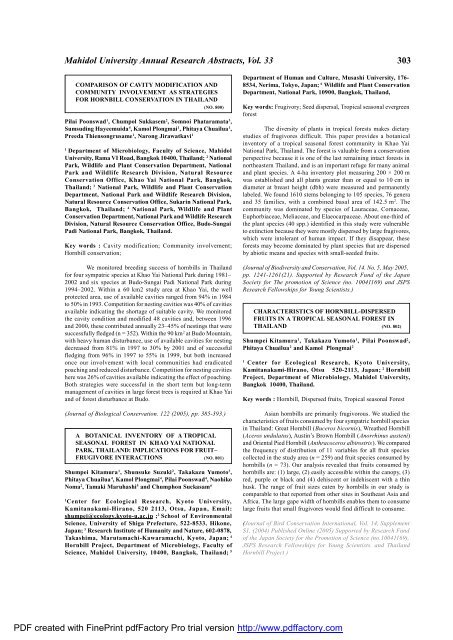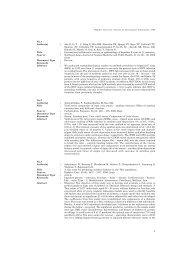Faculty of Science - Mahidol University
Faculty of Science - Mahidol University
Faculty of Science - Mahidol University
You also want an ePaper? Increase the reach of your titles
YUMPU automatically turns print PDFs into web optimized ePapers that Google loves.
<strong>Mahidol</strong> <strong>University</strong> Annual Research Abstracts, Vol. 33 303<br />
COMPARISON OF CAVITY MODIFICATION AND<br />
COMMUNITY INVOLVEMENT AS STRATEGIES<br />
FOR HORNBILL CONSERVATION IN THAILAND<br />
(NO. 800)<br />
Pilai Poonswad 1 , Chumpol Sukkasem 2 , Somnoi Phataramata 3 ,<br />
Sumsuding Hayeemuida 4 , Kamol Plongmai 1 , Phitaya Chuailua 1 ,<br />
Preeda Thiensongrusame 1 , Narong Jirawatkavi 1<br />
1 Department <strong>of</strong> Microbiology, <strong>Faculty</strong> <strong>of</strong> <strong>Science</strong>, <strong>Mahidol</strong><br />
<strong>University</strong>, Rama VI Road, Bangkok 10400, Thailand; 2 National<br />
Park, Wildlife and Plant Conservation Department, National<br />
Park and Wildlife Research Division, Natural Resource<br />
Conservation Office, Khao Yai National Park, Bangkok,<br />
Thailand; 3 National Park, Wildlife and Plant Conservation<br />
Department, National Park and Wildlife Research Division,<br />
Natural Resource Conservation Office, Sukarin National Park,<br />
Bangkok, Thailand; 4 National Park, Wildlife and Plant<br />
Conservation Department, National Park and Wildlife Research<br />
Division, Natural Resource Conservation Office, Budo-Sungai<br />
Padi National Park, Bangkok, Thailand.<br />
Key words : Cavity modification; Community involvement;<br />
Hornbill conservation;<br />
We monitored breeding success <strong>of</strong> hornbills in Thailand<br />
for four sympatric species at Khao Yai National Park during 1981–<br />
2002 and six species at Budo-Sungai Padi National Park during<br />
1994–2002. Within a 60 km2 study area at Khao Yai, the well<br />
protected area, use <strong>of</strong> available cavities ranged from 94% in 1984<br />
to 50% in 1993. Competition for nesting cavities was 40% <strong>of</strong> cavities<br />
available indicating the shortage <strong>of</strong> suitable cavity. We monitored<br />
the cavity condition and modified 48 cavities and, between 1996<br />
and 2000, these contributed annually 23–45% <strong>of</strong> nestings that were<br />
successfully fledged (n = 352). Within the 90 km 2 at Budo Mountain,<br />
with heavy human disturbance, use <strong>of</strong> available cavities for nesting<br />
decreased from 81% in 1997 to 30% by 2001 and <strong>of</strong> successful<br />
fledging from 96% in 1997 to 55% in 1999, but both increased<br />
once our involvement with local communities had eradicated<br />
poaching and reduced disturbance. Competition for nesting cavities<br />
here was 26% <strong>of</strong> cavities available indicating the effect <strong>of</strong> poaching.<br />
Both strategies were successful in the short term but long-term<br />
management <strong>of</strong> cavities in large forest trees is required at Khao Yai<br />
and <strong>of</strong> forest disturbance at Budo.<br />
(Journal <strong>of</strong> Biological Conservation. 122 (2005), pp. 385-393.)<br />
A BOTANICAL INVENTORY OF A TROPICAL<br />
SEASONAL FOREST IN KHAO YAI NATIONAL<br />
PARK, THAILAND: IMPLICATIONS FOR FRUIT–<br />
FRUGIVORE INTERACTIONS (NO. 801)<br />
Shumpei Kitamura 1 , Shunsuke Suzuki 2 , Takakazu Yumoto 3 ,<br />
Phitaya Chuailua 4 , Kamol Plongmai 4 , Pilai Poonswad 4 , Naohiko<br />
Noma 2 , Tamaki Maruhashi 5 and Chumphon Suckasam 6<br />
1 Center for Ecological Research, Kyoto <strong>University</strong>,<br />
Kamitanakami-Hirano, 520 2113, Otsu, Japan, Email:<br />
shumpei@ecology.kyoto-u.ac.jp ; 2 School <strong>of</strong> Environmental<br />
<strong>Science</strong>, <strong>University</strong> <strong>of</strong> Shiga Prefecture, 522-8533, Hikone,<br />
Japan; 3 Research Institute <strong>of</strong> Humanity and Nature, 602-0878,<br />
Takashima, Marutamachi-Kawaramachi, Kyoto, Japan; 4<br />
Hornbill Project, Department <strong>of</strong> Microbiology, <strong>Faculty</strong> <strong>of</strong><br />
<strong>Science</strong>, <strong>Mahidol</strong> <strong>University</strong>, 10400, Bangkok, Thailand; 5<br />
Department <strong>of</strong> Human and Culture, Musashi <strong>University</strong>, 176-<br />
8534, Nerima, Tokyo, Japan; 6 Wildlife and Plant Conservation<br />
Department, National Park, 10900, Bangkok, Thailand,<br />
Key words: Frugivory; Seed dispersal, Tropical seasonal evergreen<br />
forest<br />
The diversity <strong>of</strong> plants in tropical forests makes dietary<br />
studies <strong>of</strong> frugivores difficult. This paper provides a botanical<br />
inventory <strong>of</strong> a tropical seasonal forest community in Khao Yai<br />
National Park, Thailand. The forest is valuable from a conservation<br />
perspective because it is one <strong>of</strong> the last remaining intact forests in<br />
northeastern Thailand, and is an important refuge for many animal<br />
and plant species. A 4-ha inventory plot measuring 200 × 200 m<br />
was established and all plants greater than or equal to 10 cm in<br />
diameter at breast height (dbh) were measured and permanently<br />
labeled. We found 1610 stems belonging to 105 species, 76 genera<br />
and 35 families, with a combined basal area <strong>of</strong> 142.5 m 2 . The<br />
community was dominated by species <strong>of</strong> Lauraceae, Cornaceae,<br />
Euphorbiaceae, Meliaceae, and Elaeocarpaceae. About one-third <strong>of</strong><br />
the plant species (40 spp.) identified in this study were vulnerable<br />
to extinction because they were mostly dispersed by large frugivores,<br />
which were intolerant <strong>of</strong> human impact. If they disappear, these<br />
forests may become dominated by plant species that are dispersed<br />
by abiotic means and species with small-seeded fruits.<br />
(Journal <strong>of</strong> Biodiversity and Conservation, Vol. 14. No. 5, May 2005,<br />
pp. 1241-1261(21). Supported by Research Fund <strong>of</strong> the Japan<br />
Society for The promotion <strong>of</strong> <strong>Science</strong> (no. 10041169) and JSPS<br />
Research Fellowships for Young Scientists.)<br />
CHARACTERISTICS OF HORNBILL-DISPERSED<br />
FRUITS IN A TROPICAL SEASONAL FOREST IN<br />
THAILAND (NO. 802)<br />
Shumpei Kitamura 1 , Takakazu Yumoto 1 , Pilai Poonswad 2 ,<br />
Phitaya Chuailua 2 and Kamol Plongmai 2<br />
1 Center for Ecological Research, Kyoto <strong>University</strong>,<br />
Kamitanakami-Hirano, Otsu 520-2113, Japan; 2 Hornbill<br />
Project, Department <strong>of</strong> Microbiology, <strong>Mahidol</strong> <strong>University</strong>,<br />
Bangkok 10400, Thailand.<br />
Key words : Hornbill, Dispersed fruits, Tropical seasonal Forest<br />
Asian hornbills are primarily frugivorous. We studied the<br />
characteristics <strong>of</strong> fruits consumed by four sympatric hornbill species<br />
in Thailand: Great Hornbill (Buceros bicornis), Wreathed Hornbill<br />
(Aceros undulatus), Austin’s Brown Hornbill (Anorrhinus austeni)<br />
and Oriental Pied Hornbill (Anthracoceros albirostris). We compared<br />
the frequency <strong>of</strong> distribution <strong>of</strong> 11 variables for all fruit species<br />
collected in the study area (n = 259) and fruit species consumed by<br />
hornbills (n = 73). Our analysis revealed that fruits consumed by<br />
hornbills are: (1) large, (2) easily accessible within the canopy, (3)<br />
red, purple or black and (4) dehiscent or indehiscent with a thin<br />
husk. The range <strong>of</strong> fruit sizes eaten by hornbills in our study is<br />
comparable to that reported from other sites in Southeast Asia and<br />
Africa. The large gape width <strong>of</strong> hornbills enables them to consume<br />
large fruits that small frugivores would find difficult to consume.<br />
(Journal <strong>of</strong> Bird Conservation International, Vol. 14, Supplement<br />
S1, (2004) Published Online (2005) Supported by Research Fund<br />
<strong>of</strong> the Japan Society for the Promotion <strong>of</strong> <strong>Science</strong> (no.10041169),<br />
JSPS Research Fellowships for Young Scientists. and Thailand<br />
Hornbill Project )<br />
PDF created with FinePrint pdfFactory Pro trial version http://www.pdffactory.com
















